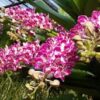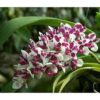# The History and Development of Dendrobium Anosmum (Đai Châu Orchid) in Vietnam

Dendrobium anosmum, commonly known as the Đai Châu orchid, is a treasured species in Vietnam, renowned for its vibrant blooms and delightful fragrance. Its unique beauty has captivated enthusiasts and collectors for generations, making it a symbol of elegance and grace. This article delves into the rich history and development of the Đai Châu orchid in Vietnam, exploring its origins, cultivation practices, cultural significance, and its role in contemporary horticulture.
## Origins of the Dendrobium Anosmum
### 1. Botanical Background
Dendrobium anosmum is part of the Dendrobium genus, which includes over 1,800 species of orchids. This particular species is native to the tropical regions of Southeast Asia, including Vietnam, Thailand, Malaysia, and the Philippines. It typically grows as an epiphyte on trees and rocks in humid environments, thriving in well-drained, airy conditions.
### 2. Discovery and Classification
The Đai Châu orchid was first described in the 19th century by botanists who were exploring the rich flora of Southeast Asia. Its scientific classification is as follows:
– **Kingdom**: Plantae
– **Clade**: Angiosperms
– **Clade**: Monocots
– **Order**: Asparagales
– **Family**: Orchidaceae
– **Genus**: Dendrobium
– **Species**: Dendrobium anosmum
The orchid was initially collected from its natural habitat and later cultivated in botanical gardens around the world, attracting attention for its stunning flowers and unique growth habits.
## Cultural Significance in Vietnam
### 1. Symbol of Beauty and Prosperity
In Vietnam, the Đai Châu orchid holds significant cultural value. It is often associated with beauty, prosperity, and good fortune. The vibrant flowers are used in various ceremonies and celebrations, symbolizing purity and joy. The orchid’s enchanting fragrance adds to its allure, making it a popular choice for festive occasions and traditional rituals.
### 2. Use in Traditional Medicine
Beyond its aesthetic appeal, Dendrobium anosmum has been utilized in traditional Vietnamese medicine. The flowers and stems are believed to possess medicinal properties, including anti-inflammatory and antioxidant effects. Local herbalists often use the orchid in concoctions aimed at improving health and well-being.
### 3. National Identity and Heritage
The Đai Châu orchid has become an integral part of Vietnam’s national identity. It is celebrated in various art forms, including paintings, poetry, and music. The orchid’s beauty is often used as a metaphor for the resilience and grace of the Vietnamese people, making it a symbol of national pride.
## Cultivation Practices in Vietnam
### 1. Traditional Cultivation Methods
Historically, the cultivation of Đai Châu orchids in Vietnam involved traditional methods passed down through generations. Local farmers would grow the orchids in their natural habitats, often on trees or rocks, utilizing the natural moisture and humidity of the environment.
#### a. Selecting Suitable Locations
Farmers would identify suitable locations for cultivation, focusing on areas with adequate sunlight, humidity, and airflow. They would often choose shaded regions with good drainage to prevent root rot, ensuring optimal growth conditions for the orchids.
#### b. Propagation Techniques
Propagation of Đai Châu orchids traditionally involved division and cuttings. Experienced growers would carefully divide mature plants, ensuring that each division had healthy roots and growth points. This method allowed them to increase their stock and share the orchids with other enthusiasts.
### 2. Modern Cultivation Techniques
In recent years, the cultivation of Đai Châu orchids in Vietnam has evolved with advancements in horticultural practices. Modern techniques have improved the efficiency and success rate of orchid cultivation, enabling growers to produce healthier plants with vibrant blooms.
#### a. Greenhouse Cultivation
Many orchid enthusiasts now use greenhouse cultivation to control environmental conditions more effectively. Greenhouses provide a controlled environment, allowing growers to regulate temperature, humidity, and light levels, promoting optimal growth.
#### b. Tissue Culture Technology
The introduction of tissue culture technology has revolutionized orchid propagation in Vietnam. This method involves growing orchid cells in a sterile environment, allowing for the mass production of disease-free plants. Tissue culture enables growers to produce large quantities of Đai Châu orchids quickly, meeting the growing demand from both domestic and international markets.
### 3. Challenges in Cultivation
Despite the advancements in cultivation practices, growers still face challenges when cultivating Dendrobium anosmum orchids. Some of these challenges include:
#### a. Pests and Diseases
Pests such as aphids, mealybugs, and spider mites can pose significant threats to orchid health. Additionally, diseases like root rot and fungal infections can devastate crops if not managed effectively. Growers must implement integrated pest management strategies to minimize these risks.
#### b. Environmental Factors
Changes in environmental conditions, such as climate change and urbanization, can impact the natural habitats of Đai Châu orchids. The loss of natural habitats and increased pollution pose challenges to the long-term sustainability of orchid populations.
## The Role of Đai Châu Orchids in Vietnamese Horticulture
### 1. Commercial Cultivation
The commercial cultivation of Đai Châu orchids has gained popularity in Vietnam, driven by the increasing demand for orchids both domestically and internationally. Nurseries specializing in orchids have emerged, providing a variety of species and hybrids to cater to a diverse clientele.
#### a. Export Potential
Vietnam has positioned itself as a significant player in the global orchid market. The Đai Châu orchid, with its unique beauty and fragrance, is sought after in international markets. Exporting orchids contributes to the country’s economy and promotes the cultural heritage of Vietnamese horticulture.
#### b. Orchid Shows and Competitions
To promote the cultivation and appreciation of Đai Châu orchids, various orchid shows and competitions are held throughout Vietnam. These events provide a platform for growers to showcase their best specimens, exchange knowledge, and connect with fellow enthusiasts. They also serve to educate the public about the importance of orchid conservation.
### 2. Environmental Conservation
As the popularity of Đai Châu orchids grows, there is an increasing awareness of the need for environmental conservation. Efforts are being made to protect natural habitats and promote sustainable cultivation practices.
#### a. Conservation Initiatives
Organizations and government agencies are working to conserve the natural habitats of Dendrobium anosmum and other native orchids. This includes establishing protected areas and implementing regulations to prevent illegal collection and trade of wild orchids.
#### b. Education and Awareness
Educational programs aim to raise awareness about the importance of orchid conservation and the role of Dendrobium anosmum in Vietnam’s biodiversity. Workshops, seminars, and community outreach programs encourage sustainable practices among growers and promote the appreciation of orchids as a vital part of the ecosystem.
## Cultural Events Celebrating Đai Châu Orchids
### 1. Festivals and Exhibitions
Throughout Vietnam, various festivals and exhibitions celebrate the beauty of Đai Châu orchids. These events often feature flower displays, cultural performances, and educational workshops, attracting both locals and tourists.
#### a. Flower Festivals
Flower festivals held in major cities showcase the vibrant colors and varieties of Đai Châu orchids. Visitors can enjoy the sight of thousands of blooming orchids, participate in workshops, and learn about cultivation techniques.
#### b. Cultural Performances
Cultural performances during orchid festivals often include traditional music, dance, and art exhibitions. These performances highlight the significance of orchids in Vietnamese culture and the artistic expressions inspired by their beauty.
### 2. Community Engagement
Local communities play a vital role in celebrating the Đai Châu orchid’s cultural significance. Community events often involve orchid displays, workshops, and educational programs aimed at fostering appreciation for these beautiful flowers.
#### a. School Programs
Educational programs in schools focus on the importance of orchids in Vietnamese culture and ecology. Students learn about the cultivation, care, and conservation of orchids, fostering a sense of responsibility for the environment.
#### b. Local Workshops
Workshops conducted by local horticulturists and enthusiasts provide hands-on training in orchid care and cultivation. These workshops empower individuals to grow their orchids, promoting sustainable practices and enhancing community engagement.
## Future Prospects for Dendrobium Anosmum in Vietnam
### 1. Continued Research and Development
The future of Dendrobium anosmum in Vietnam will be shaped by ongoing research and development efforts. Researchers are exploring new cultivation techniques, pest management strategies, and breeding programs to enhance the quality and resilience of Đai Châu orchids.
### 2. Sustainable Practices
As the demand for orchids grows, the importance of sustainable practices will become increasingly vital. Emphasizing eco-friendly cultivation methods, such as organic farming and integrated pest management, will ensure the long-term health of orchid populations.
### 3. Global Collaboration
Collaborations with international orchid societies and horticultural organizations can foster knowledge exchange and promote the conservation of Đai Châu orchids. By sharing best practices and resources, Vietnam can continue to thrive as a center for orchid cultivation and appreciation.
## Conclusion
The Đai Châu orchid, or Dendrobium anosmum, has a rich history and cultural significance in Vietnam. From its origins in the tropical forests of Southeast Asia to its prominent role in Vietnamese horticulture, this stunning flower has captured the hearts of many. As cultivation practices evolve and awareness of conservation efforts grows, the future of Đai Châu orchids in Vietnam looks promising.
Through continued research, sustainable practices, and community engagement, the Đai Châu orchid will remain a cherished symbol of beauty and resilience in Vietnamese culture. Its vibrant blooms will continue to adorn homes, gardens, and public spaces, enriching the lives of those who appreciate its elegance and fragrance. The journey of Dendrobium anosmum in Vietnam is a testament to the enduring connection between nature, culture, and the human spirit.

